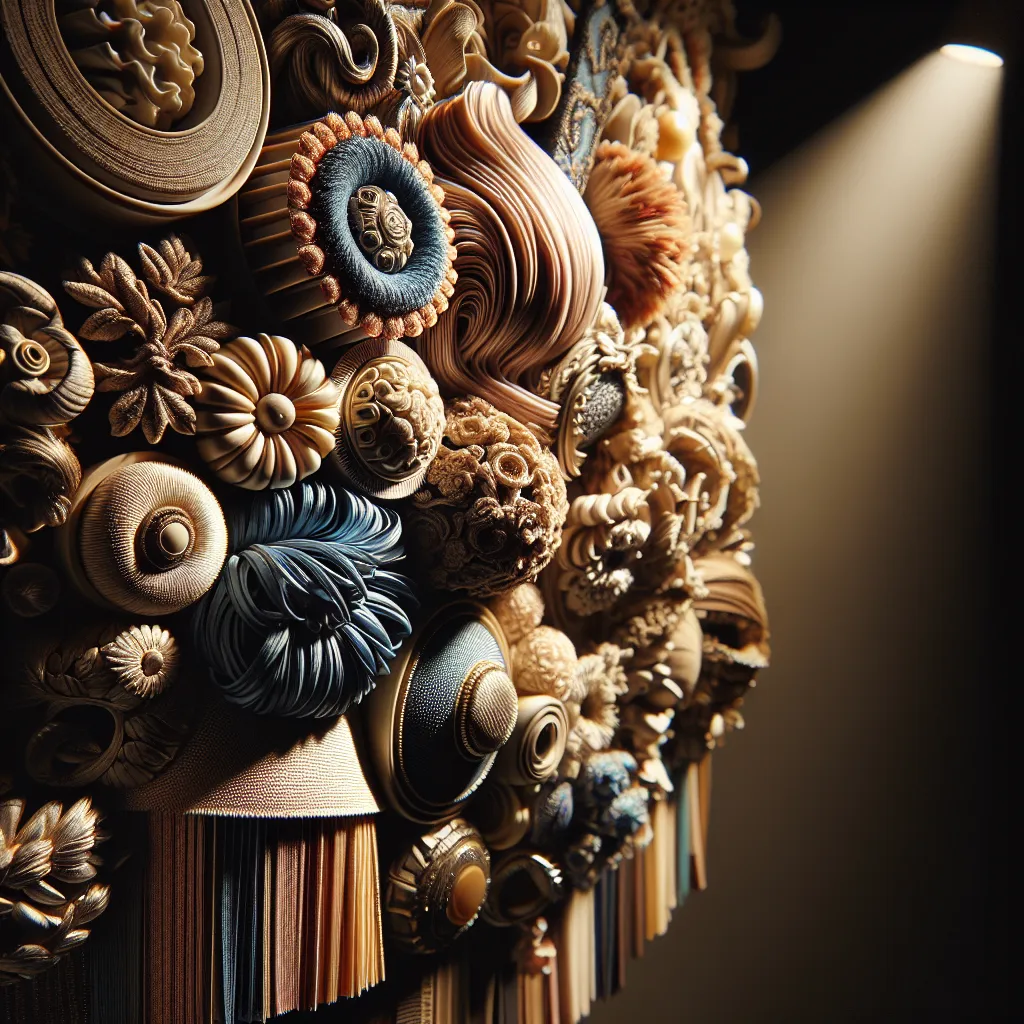Exploring the Role of Trimmings in Creating Textured Interiors
When it comes to interior design, the role of trimmings in creating textured interiors cannot be overlooked. Trimmings, such as fringes, cords, tassels, and braids, have long been utilized as decorative elements, but their innovative applications have brought a new dimension to interior design. By strategically incorporating trimmings, interior designers can add depth, visual interest, and a tactile quality to various surfaces, ultimately contributing to the creation of richly textured interiors.
One of the key innovative applications of trimmings in interior design is their use to embellish upholstery. By adding trims to furniture such as sofas, chairs, and cushions, designers can introduce a layer of texture that not only enhances the visual appeal but also creates a more immersive sensory experience for the occupants. Furthermore, the strategic placement of trimmings can highlight the contours of furniture pieces, adding a sense of luxury and elegance to the overall interior space.
Additionally, trimmings are being increasingly used to manipulate the perception of space within interiors. By employing trims on draperies, curtains, and blinds, designers can introduce tactile elements that interact with light and shadow, thereby adding dynamic texture to the surfaces. This not only creates visual intrigue but also transforms the way light is diffused within a space, ultimately influencing the ambiance and atmosphere of the room.
Moreover, the innovative use of trimmings extends to wall coverings and finishes. By incorporating trims into wall panels, wallpaper borders, or even directly onto walls, designers can create three-dimensional patterns and designs that engage both the visual and tactile senses. This approach not only offers a unique way to introduce texture but also allows for a personalized and bespoke interior aesthetic.
In conclusion, the innovative applications of trimmings in interior design play a crucial role in exploring and creating textured interiors. Designers are continuously pushing the boundaries of traditional trimmings usage, leveraging these elements to add depth, visual interest, and tactile richness to interior spaces, ultimately shaping immersive and captivating environments.
Unconventional Use of Trimmings: A Fresh Approach to Interior Design
When it comes to interior design, the use of trimmings has often been confined to traditional applications such as edging on curtains or upholstery. However, a fresh and innovative approach to interior design has emerged, showcasing the unconventional use of trimmings in a variety of creative ways. Designers are increasingly incorporating trimmings in unexpected ways, adding an element of surprise and sophistication to interior spaces.
One of the innovative applications of trimmings in interior design is their use as decorative elements on furniture. By incorporating fringe, tassels, or beaded trims on furniture pieces such as chairs, ottomans, or cabinets, designers can add an extra layer of texture and visual interest to the furniture, transforming them into unique and eye-catching statement pieces.
Furthermore, trimmings are being employed to create bespoke wall treatments and artwork. Intricately woven trims can be used to form stunning geometric patterns or intricate designs on walls, adding a touch of luxury and elegance to the space. Additionally, designers are utilizing trimmings to create three-dimensional artwork, elevating the visual impact of interior walls.
In the realm of lighting design, trimmings are being integrated in innovative ways, serving as decorative accents on lampshades or chandeliers. Whether it’s incorporating delicate lace trims on lampshades or cascading beaded trims on chandeliers, the unconventional use of trimmings brings a new dimension to lighting design, casting captivating patterns and creating a mesmerizing play of light and shadow in interior spaces.
This fresh approach to interior design, characterized by the unconventional use of trimmings, offers endless possibilities for creativity and expression. By pushing the boundaries of traditional applications, designers are able to infuse spaces with a sense of individuality and charm, redefining the role of trimmings in interior design.
Enhancing Design Aesthetics: Trimmings as Versatile Accents in Interior Decor
When it comes to interior design, every little detail matters. Trimmings, often seen as an afterthought, are now gaining recognition for their versatile and innovative applications in enhancing design aesthetics. These decorative elements, such as fringes, tassels, cords, and braids, have traditionally been used to add a finishing touch to soft furnishings like curtains, cushions, and upholstery. However, their role has evolved to become more prominent, serving as versatile accents that can elevate the overall interior decor.
One of the most innovative applications of trimmings in interior design is their use as decorative borders and accents on furniture. By incorporating trimmings along the edges of sofas, chairs, and ottomans, designers can add a touch of sophistication and luxury to the furniture pieces. Whether it’s a subtle contrast piping or a bold, statement fringe, trimmings offer endless possibilities for customization, allowing designers to match the trimmings to the overall theme and color scheme of the space.
Furthermore, trimmings are being employed to create one-of-a-kind wall decor. In lieu of traditional wallpaper borders, decorative trims are being used to delineate wall panels, create geometric patterns, or even form intricate designs directly on the walls. This unconventional use of trimmings adds texture, depth, and visual interest to the walls, effectively making a design statement that goes beyond the conventional wall treatments.
Another remarkable application of trimmings is their incorporation in lighting fixtures. Designers are utilizing decorative cords and tassels to embellish lampshades, chandeliers, and pendant lights, transforming these functional elements into focal points that exude elegance and style. The interplay of light with the intricate details of the trimmings further enhances the ambiance of the space, establishing a captivating visual interplay.
In essence, trimmings have transcended their conventional role and emerged as innovative tools for interior designers to add depth, personality, and character to spaces. Their versatility in enhancing design aesthetics makes them an indispensable asset in the ever-evolving world of interior decor, opening up new realms of creativity and expression.
Innovative Integration: Trimmings as Functional and Decorative Elements in Interior Design
Trimmings have long been used as decorative elements in interior design, but their innovative integration as both functional and decorative elements is revolutionizing the way we approach interior décor. Traditionally, we have seen trimmings used primarily as embellishments on furnishings, draperies, and upholstery. However, designers are now pushing the boundaries by using trimmings in a more innovative and multifaceted manner.
One of the most exciting applications of trimmings in interior design is their integration as functional elements. For instance, we are now seeing trimmings being used to create functional and decorative borders on rugs and carpets, adding both visual interest and defining specific areas within a space. Additionally, designers are using trimmings to create decorative and functional room dividers, adding a touch of elegance while also serving a practical purpose.
Furthermore, trimmings are being integrated into lighting fixtures and mirrors, adding intricate details and a sense of luxury to these functional elements. By incorporating trimmings into these typically utilitarian items, designers are able to elevate the overall aesthetic of a room while also adding a unique and personalized touch.
Innovative integration of trimmings also extends to the use of smart textiles that incorporate functional elements such as LED lighting or sound absorption properties. These high-tech trimmings not only serve a practical purpose but also contribute to the overall design scheme, showcasing the potential for trimmings to be at the forefront of both functionality and aesthetics in interior design.
In conclusion, the innovative integration of trimmings as both functional and decorative elements in interior design opens up a world of creative possibilities. By exploring new ways to incorporate trimmings into various aspects of interior décor, designers are redefining the role of trimmings and showcasing their potential to transform a space into a true work of art.
Remember to check out our comprehensive guide on the most innovative applications of trimmings in interior design for more inspiration and ideas on how to incorporate these versatile elements into your own design projects.

